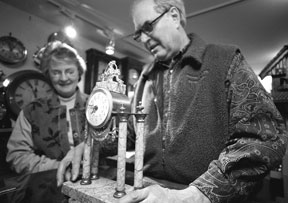Herb Helsel has never met a clock he didn’t like.
No matter how old the clock, no matter how small and numerous the gears, bushings and other widgets in the mechanism, every clock he puts his hands and tools upon is a work of art.
One of an increasingly rare breed of clock repairmen, Helsel is the one guy on Whidbey Island you want fixing your 250-year-old grandfather clock or the cuckoo clock somebody in the family brought back from Japan after World War II.
In his shop on Frick Lane in downtown Langley, Langley Clock and Gallery, Helsel has been quietly fixing clocks for the past two years in a shop that is sometimes open and sometimes not. It seems to flit in and out of the attention of passersby like the phantom, witches-only shopping district in “Harry Potter and the Sorcerer’s Stone.”
But when someone does discover the shop open and decides to enter, it is unlike anything most people have ever seen.
“When people find it, they think they’ve found the secret clock place,” Helsel said.
Walking inside is to step backwards a century or two. Sprawling through a half dozen rooms in the long, narrow first story of the Frick Building, Helsel’s shop is packed with wall clocks, mantel clocks and grandfather clocks, most 100 years old or older. The clocks tick and sparkle. Some cuckoo on the hour. In one room, where grandfather clocks stand like ancient knights, the practice of keeping time is downright intimidating.
Many of the clocks in the shop — which are a mix of antiques and new — are for sale, but about 70 of them are there to be fixed. And even though the turnaround time to repair a clock is about six months, more people bring their precious clocks in every week.
While Helsel’s wife Marilyn — another admitted clock nut — takes care of most of the clock sales, Herb Helsel spends much of his time in a well-lit corner of the shop doing the unthinkable: He opens up clocks that are, on average, more than 100 years old and pulls apart their mechanisms, right down to gear pieces so small than a couple hundred would fit into a thimble.
Possessed of more precision and patience than seems possible, Helsel spends his days giving life back to timepieces that, in some cases, have counted the hours of the day for more than 10 generations. A machinist by trade, Helsel learned to the art of rebuilding old clocks from his uncle after selling his motorcycle dealership seven years ago.
There are a lot of similarities between the motorcycle repair and clock repair businesses. Both involve drill presses, metal shaping tools, and the ability to keep track of hundreds of pieces of metal at one time. The challenge to his new business is that the pieces are a whole lot smaller.
Even so, he said, taking apart a clock is no small matter.
“You have to feel like this is the day to take it apart,” he said. “It’s not something you do in a hurry.”
When repairing an old clock, Helsel has to contend with not only an obvious problem pointed out by a customer — usually that the clock isn’t running any more — but all the surprises he inevitably finds inside once the day comes to open the mechanism. Though the gears, shafts and tiny wire cog teeth inside the clocks were precision manufactured by masters 100 or 200 years ago, centuries of wear and the lower grade of materials available in the 18th and 19th centuries take their toll.
Helsel said he never makes judgements about the quality of the workmanship or the repairs he finds. He just works to correct the problems.
“A lot of it is undoing what other people have done,” he said.
Sometimes, the work is as easy as replacing a worn spring with a new one. Other times, he has to push out tiny brass bushings and replace them with new ones to eliminate play in the shafts that turn a clock’s gears. Most challenging are the tiny holes that hold the wire shaft teeth driving clock gears. Sometimes more narrow than a human hair, these holes can require drilling with steel bits as small as 4/1000 of an inch.
To finish, Helsel buffs new parts obsessively to camouflage his work. With luck, no one will be able to tell his hands were ever inside a clock. However, in the near future he plans to begin leaving one obvious sign behind. He plans to revive the centuries-old tradition of signing and dating the back of every clock he repairs. This was something he didn’t want to do until he was sure he had full mastery of his craft.
“It took some getting used to,” he said.
Every clock Helsel touches gets special treatment. He said even if they haven’t gotten the best maintenance over the years, it’s always his goal to make certain they go back home ready to run for another century or two.
It’s about time.



